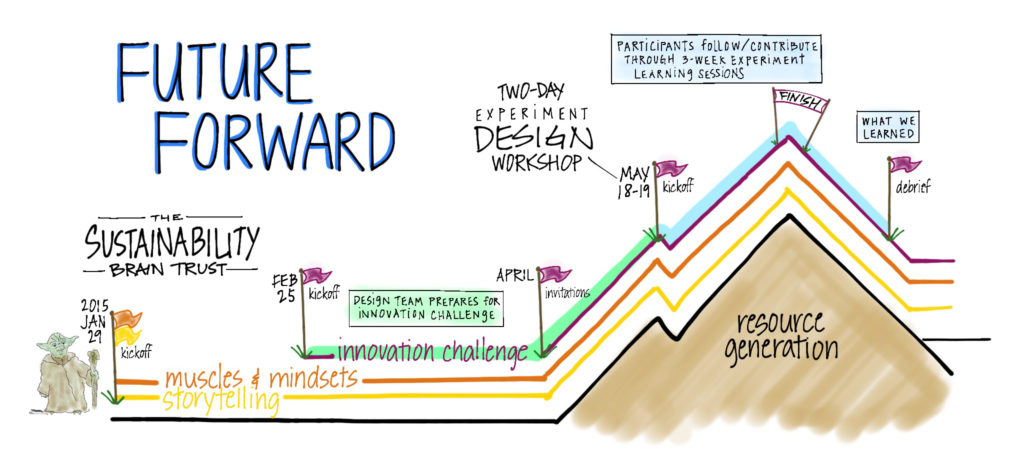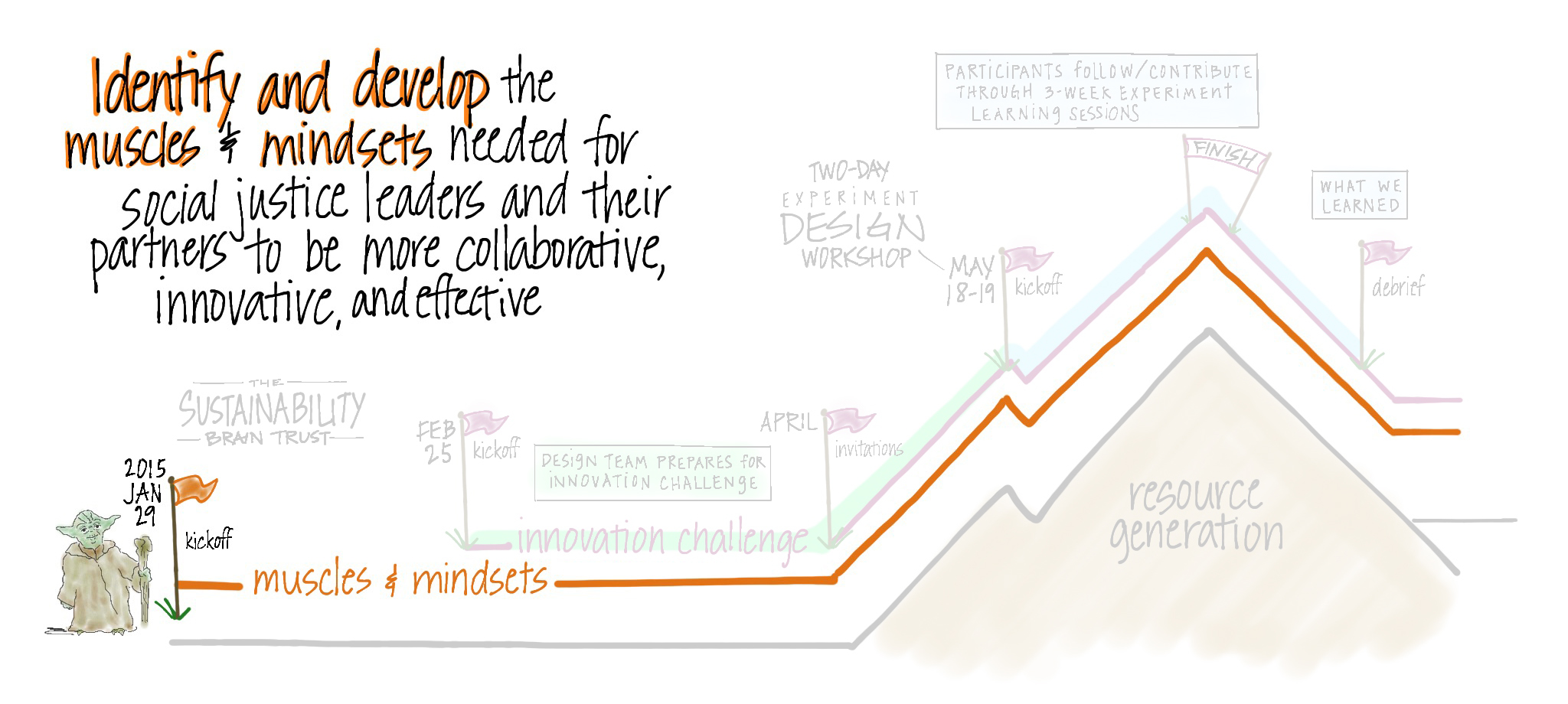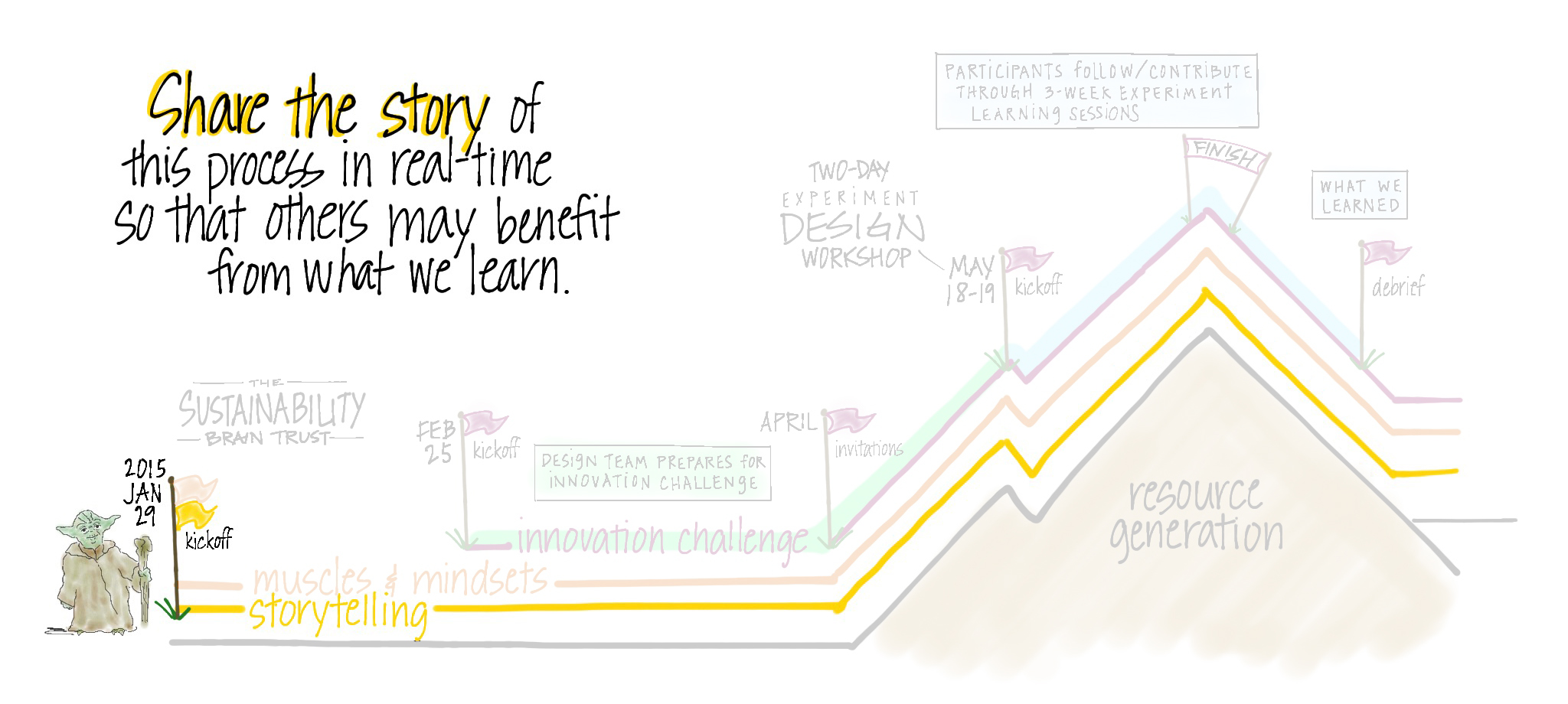Contents
Background
Design
Innovation Challenge
Muscles & Mindsets
Storytelling
Motivation
Principles
Future Forward is a six-month innovation process designed to explore and experiment with bolder ideas to resource and support Forward Together at a deeper, more strategic level. Through this engagement, the team of stakeholder participants seek to answer the question:
How can resources be generated differently to enable Forward Together and the social justice field at large to evolve sustainably, with agency and autonomy, toward a future in which all families can thrive?
Background
Future Forward began as a conversation in May 2014 between Eveline Shen, Executive Director of Forward Together, Holly Bartling, Program Officer at General Service Foundation, and Eugene Eric Kim of Faster Than 20. It was catalyzed by Lani Shaw, the late Executive Director of General Service Foundation, who thought that something valuable might emerge if this group explored possibilities together. It was further informed by thinking that emerged from the Management Assistant Group’s Networked Leaders Innovation Lab.
After several conversations, the idea for this project began taking shape, and the group began to recruit an initial set of participants and some additional consultants to support the process. Future Forward kicked off on January 29, 2015 at the Forward Together Oakland office.
Design
The Future Forward innovation process has three components: an innovation challenge, muscles & mindsets, and storytelling.
Innovation Challenge
At the project’s core is an Innovation Challenge, where Forward Together staff, foundation supporters, and other stakeholders will come together to:
- Brainstorm and evaluate ideas.
- Experiment with these ideas over three months.
- Prepare to build on what we learn.
Muscles & Mindsets
A common problem with many innovation processes is that they focus on generating ideas without paying enough attention to the participants’ ability to execute those ideas. It’s akin to asking participants to run a 10K race without considering whether or not they are in shape.
Innovation require the right “muscles” and mindsets to work. In addition to the Innovation Challenge, core participants are participating in an intensive six-month Muscles & Mindsets program designed to help instill the right culture and create a safe space for participants to practice the skills they need to be more collaborative and innovative.
Storytelling
Throughout the entire six months, the participants will be sharing what they learn in real-time here on this website. It’s an opportunity for all of us to further develop our “muscles” for storytelling and working in open, transparent ways. It will also hopefully serve as a place for others in the field to watch what unfolds in real-time and to learn with us.
What does success look like?
Motivation
What does it take for a strong organization (Forward Together) that is leading an ambitious network (Strong Families) to get to scale? What role should philanthropy be playing to support this?
Forward Together is one example among many of a social justice organization that has developed bold, long term campaigns that involve many state and national organizational partners. These social justice leaders have turned to highly complex, networked campaigns to unite organizations around a common vision and platform. This innovation has resulted in visionary, visible initiatives — such as Caring Across Generations, We Belong Together, and United We Dream — that are gaining allies and building momentum.
Yet Forward Together and many of its peers are facing a similar challenge. They can’t generate resources at the scale needed to build sustainable infrastructure. They have big visions, but they don’t have the staff and resources to implement it at the level they need to bring about true change. The real cost of inaction is burnout of some of the social justice movement’s strongest leaders.
Are there other sources of funding that haven’t been explored that might help resource this work and accelerate our rate of change? In searching for these answers, can we try out a new, more networked way of operating, where funders and activists find a way to overcome both structural and cultural challenges together? Can we operate from a deeper place of trust, build stronger relationships, and approach this challenge with a mindset of abundance?
Principles
In order to make sector-wide change in the social justice field, we need to develop processes that work, we need to understand how to put those processes into practice, and we need to share the story of what works and what doesn’t. Specifically, we need to:
Think big and systemically. The social justice sector faces many systemic challenges that limit the ability of organizations to grow and thrive. We need to acknowledge these challenges and understand how we are unintentionally contributing to them.
Start small. While we must hold a larger vision, we must find ways to take small, concrete steps forward. Part of that is by finding ways that we can improve, rather than looking at changing others.
Build on existing work and relationships. We are not starting from scratch. We need to celebrate the great work from all parties that is already happening toward these goals, and we need to find a way to build on this work, rather than create new work. We also hope that we build new relationships as part of this process, to expand our vision of who a funder is, and explore alternative mode of resourcing our work.
Focus on capacity-building. This should not just be about coming up with good ideas. This needs to be about coming up with good ideas and building the capacity of participants (both social justice leaders and funders) to implement and learn from them. The success of this project revolves around our ability to build our collective capacity to do this work.
Emphasize story. If we want to have a broader, faster impact on the field as a whole, we need to be intentional about telling the story of our work — both warts and triumphs — as it happens. Storytelling is not something you can outsource. The participants need to play an active role in this process. We also need to find creative, lightweight, delightful ways to tell this story beyond the usual case study format.



